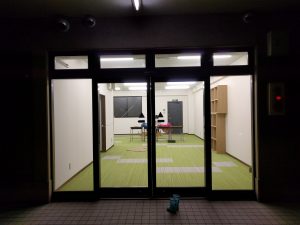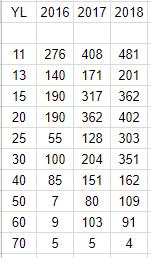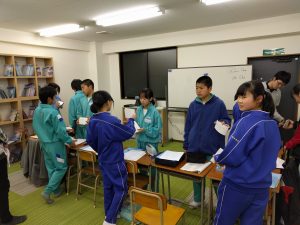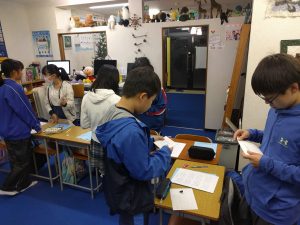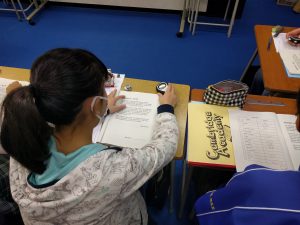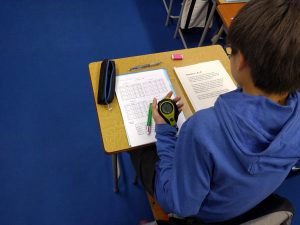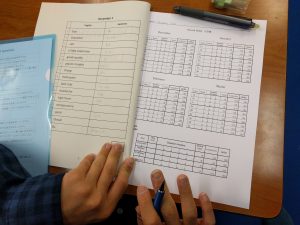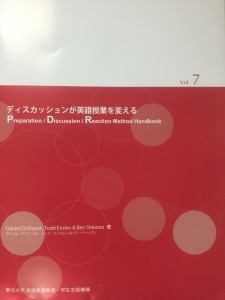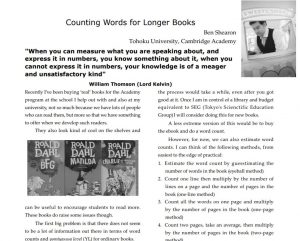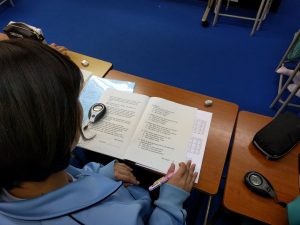Cambridge Academy: Stocktake 2018
We just finished our annual stocktake. You can see last year’s post here. Last year we bought a lot of duplicate sets of YL3-5 books to accommodate our larger classes of junior high school first years.
I was pleasantly surprised to see some of the books that were missing in the last stocktake were back this time, meaning that someone had just forgotten to return them during stocktake week or had been absent. This is the third year of doing stocktakes, and despite not tracking book lending at all, we seem to have only lost a negligible number of books (and they may come back at some point too).
We didn’t quite reach 10,000 books, but we’re close and should cross that line within the next month or so.
The lower levels (YL1-10) mainly consist of multiple copies of books (up to ten copies of each book/set), while the higher levels are mostly individual titles. I would like to expand our range for YL11-80. Our highest level students (reading at YL50 or so) have just graduated, so the highest students from April will be YL40-ish.
Looking at our usage patterns from the last couple of years, new students tend to start YL1 together, go on to YL2 together, then start diverging. Our current first years (soon to be second years) are reading YL3-6, with most of them on YL3-4, a few on YL5, and one on YL6. This means we need the most books at YL1-5, as that is where the faster first years and the slower second years are going to bump into each other. I think students reading above YL5 will probably remain spread out, although we might have to shore up YL6-10 a bit once our larger cohorts get there in the next year or two.
This library will serve 90-some students next year. The current maximum capacity of the Academy is something like 144. If we beef up the upper levels a bit our current books should be adequate for that. Ultimately I would like to rent a third classroom, which would give us a capacity of just over 200. Having said that, I was hoping to have 100 students by the second year 😉
We’ll see how things go.
Academy curriculum junior high school language courses materials publications school management textbooks
by sendaiben
leave a comment
The Academy Fluency Course
The Cambridge Academy is a six-year English program for junior and senior high school students at Cambridge English School in Sendai. You can read previous Academy posts here:
- Extensive Reading for Secondary Students (April 2015)
- Six Months In (September 2015)
- Year One (February 2016)
- Looking at Year Two (March 2016)
- Stocktake (March 2016)
- Shadoku explained (April 2016)
- Some improvements to the curriculum (April 2016)
- December 2016 update (December 2016)
- Cambridge Academy: Year Two and Three (March 2017)
- Cambridge Academy: Stocktake 2017 (March 2017)
- Cambridge Academy: Another Quantum Leap (April 2017)
- Cambridge Academy: Year Three Mid-Year Update (August 2017)
- Cambridge Academy: Year Three Student Progress (October 2017)
- Cambridge Academy: Year Three and Four (February 2018)
Background
The fluency course was not originally part of the Academy plan. Originally I wanted to run the Academy purely as an extensive reading course that would supplement what students were doing at school (and cram school/juku). This is much easier logistically and makes scheduling and running classes very simple. It’s also more profitable as you can fill classes with students of different levels.
This first iteration of the Academy did not work well. We found that without help it was difficult for students to learn English just from reading. We also found that students did not form a social bond with the school or their peers and thus missed out on motivation. Some students did well with the ER-only model, but many did not.
The second iteration of the Academy imitated SEG in having reading classes and communication classes. For the latter we used commercial textbooks. This worked better than ER-only, but there were problems with the tone, content, amount of material, and amount of repetition in the textbooks. The classes also worked well if run by an experienced engaged teacher but less well with less experienced teachers.
In order to deal with these problems, we created the Academy Fluency Course. It was written from scratch, extensively trialled with our classes here, and is designed to provide students with huge amounts of repetitive practice in reading, speaking, listening, and writing. Fluency is gained by repeating tasks you can already do, and the goal of the Fluency Course is not to teach students new language (although they do encounter huge amounts of new vocabulary and grammar in the course) but rather to allow them to practice enough to internalise some of the language they know and become fluent in using it.
The Cambridge Academy now consists of 140 minute classes: 20 minutes of workbook/school work/individual study, 60 minutes of input (extensive reading and listening), and 60 minutes of output (fluency course).
The Academy Fluency Course
Junior high school 1: Year One (these materials are in beta and are described in detail below).
The theme for this level is the students daily and school lives.
Junior high school 2: Year Two (these materials are in alpha).
The theme for this level is Japan. Students read and talk about different areas/aspects of Japan.
Junior high school 3: Year Three (these materials are not written yet).
The theme for this level is the world. Students read and talk about different areas/aspects of the world.
Senior high school initial course for first and weaker second years: (these materials are not written yet).
This level will provide a transition between the junior high school materials and the advanced course below.
Senior high school advanced course for stronger second and third years: (this is being written now).
This level is based on the PDR method and involves students reading, thinking, discussing, and writing about topics each week.
In 2017 we ran classes using the Year One materials. Halfway through the year we started writing the Year Two materials with the second and third graders. The plan is to write Year Three this year alongside the advanced high school course and to use them with the third year JHS and our advanced high school class.
Fluency Course Year One
The first year of the Fluency Course is based on the first year junior high school textbooks and has the following student components:
- 12 4-week student textbooks (April to March) with a total of 512 pages and 84,249 words
- a 48-unit student writing workbook
- 12 monthly reference sheets with questions and vocabulary
- 3 4-month student record sheets
There are also reference/class/teacher components
- 240 index cards with questions and answers (you will need one set for every two students in the class for pair work)
- 48 verb exercise answer sheets (you will need one for each student in your largest class)
- 48 Quizlet vocabulary and question datasets (available through the Quizlet website)
The main component is the student textbook, split into twelve montly booklets. It provides the vocabulary and questions for all the other components. The April book is slightly different from the others because it provides a gentle introduction. Each book contains the following:
Week One and Two
Vocab quiz (15 items from the timed reading texts, previewed by Quizlet)
3 timed reading texts with questions (April 45 words, May-July 60 words, August-November 80 words, December-March 100 words)
Verb conjugation table (to be read aloud -one verb per week)
Timed verb translation (30 items)
Example dialogue for reading and memorizing (April-July 3 exchanges, August-November 4 exchanges, December-March 5 exchanges)
Week Three
No example dialogue. Instead students write their own (length as above).
April has example dialogue.
Week Four
Instead of three short timed readings, there is one reading with three times the word count.
Teacher corrects and chooses the best student dialogues, then prints them for students to practice with.
April has example dialogue.
Results
The Fluency Course depends somewhat on the fact that students are also learning English at school. It is designed to cover the gaps in students learning, mainly speaking, reading, and writing exercises, and particularly drilling these.
So far results have been very encouraging. Our students are not all particularly academic or motivated, and it has been very encouraging to see all of them improve and succeed using the Fluency Course. More able/advanced students are able to challenge themselves within the course, while weaker ones can support themselves and keep up.
I will write a description of an output class in a future blog post.
Preparation Discussion Reaction: The PDR Method
How to get students speaking, discussing, and writing about real topics
Almost two years after it was first published, the PDR Handbook is finally available online.
PDR is a groundbreaking method for running 4-skills language classes for intermediate and above students. It can also be adapted for use with content classes. I have also used it successfully for teacher workshops.
You can download a copy of the Handbook in PDF format from here.
Estimating Word Counts for Longer Books (Extensive Reading)
I just realised my article on estimating word counts for longer books is online here in the Extensive Reading Journal.
It compares various methods for estimating word counts of longer books. See what you think!
Cambridge Academy: Year Three and Four
You can read previous Academy posts here:
- Extensive Reading for Secondary Students (April 2015)
- Six Months In (September 2015)
- Year One (February 2016)
- Looking at Year Two (March 2016)
- Stocktake (March 2016)
- Shadoku explained (April 2016)
- Some improvements to the curriculum (April 2016)
- December 2016 update (December 2016)
- Cambridge Academy: Year Two and Three (March 2017)
- Cambridge Academy: Stocktake 2017 (March 2017)
- Cambridge Academy: Another Quantum Leap (April 2017)
- Cambridge Academy: Year Three Mid-Year Update (August 2017)
- Cambridge Academy: Year Three Student Progress (October 2017)
The Academy is still going well, although we ran into an unexpected problem this year. I’m still having a lot of fun and the students are doing extremely well. I’m particularly encouraged by the fact that all our struggling learners have built a solid base and are no longer struggling!
Good news
There is quite a bit of this. We have finally taken the plunge and rented a new classroom next to our main classroom. This will give us a dedicated Academy classroom (that will be used by other classes in the daytime) and allow us to have all classes do reading first and fluency second. This matters because doing it the other way around results in students trying to read at the end of the day when they are tired from actively speaking and writing English. It also means that we will be able to increase fluency class sizes to twelve.
In the schedule for next year I am not in charge of any classes. I will definitely be there every day, at least to start with, and will work with all the teachers to set up routines and address problems. Once the classes are running smoothly though, I plan to cut down to 3/4, 1/2, or even 1/4 class time. I think at least for now I will want to go to each class at least once a month at a minimum.
We’ve started working with a marketing expert to redesign the school website, improve our online advertising, and write new copy for all our marketing/informational materials. So far it’s been really helpful, and I’m excited to see if it makes any difference to our recruitment. Just having the website say what we mean more clearly has been completely worth the cost so far though.
We’ve been filling holes in classes by having the odd student join and also by persuading students to shift from input only (extensive reading) to input and output (fluency course). We currently have space for five more new second years and ten more new third years.
The fluency course materials are really coming along. We made some great little tweaks this year and the course is a lot more solid. We have pretty much finished the second year materials and are thinking about what the third year will look like. I’ll write a post about the fluency course soon.
Bad news
There is one piece of bad news, but it’s a doozy. Last year pretty much all our elementary school sixth grade students joined the Academy when they moved to junior high school. This year we had 31 sixth grade students and we assumed (hah!) that they would pretty much all join. At the same time we made some changes to how we handled the signup and explanation sessions.
Well, right now we only have 19 students signed up for the input+output course, and one for input only. We have a couple of trial students who are interested too, but as our capacity is 36 this is pretty bad.
I’m hoping a combination of some people changing their mind, some people introducing their friends, and some people seeing the new website will help, but otherwise instead of three classes of twelve we’re looking at one class of six, one of four, and one of nine. One of the best things about the fluency classes is the atmosphere from larger groups, so I am a bit worried about the smaller classes.
We have two months to find another 16 junior high school first years to join the input+output course. Wish us luck!
Next steps
We need to buy a lot of new books and get ready for next year. We are hoping to hire one more intern to join our current three. I am planning to write a couple of blog posts (one about the fluency course and the regular stocktake post). We need to get the new classroom set up once we get the key on March 1st.
Any questions?
